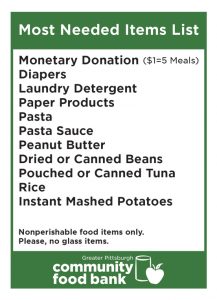The season of giving is upon us, and while we’re gathering with friends and family and enjoying meals, it’s also important to remember those less fortunate.

One in eight people will go hungry this holiday season. While the economy may be improving since the Great Recession, many Americans are still feeling the effects of underemployment, stagnant wages and rising costs of living. In fact, more than 46 million people each year turn to Feeding America, the largest nationwide network of food banks in the country, for extra support. The Greater Pittsburgh Community Food Bank is part of this support network, and employees work year-round to combat staggering statistics in the local region.
“More than 322,000 people are considered food insecure in our 11 county region in Southwestern Pennsylvania,” said Beth Burrell, Communications and PR manager at the Greater Pittsburgh Community Food Bank (the Food Bank). “That means, those individuals don’t know where their next meal is coming from.”
That number includes more than 84,000 children.
Food-insecure households are not necessarily food insecure all the time, Feeding America’s website explains. This term may reflect a household’s need to make trade-offs between important basic needs, such as housing or medical bills, and purchasing nutritionally adequate foods.
With the help of donations, the Food Bank distributes more than 31 million meals to local people in need through food pantries, after school programs, senior centers and soup kitchens.
What the Food Banks needs
If you’re considering donating items this season, Burrell offers some advice.
“If you think about what you would like to see at your dinner table, that’s the same things that our families are looking for. Anything that would help make a holiday meal would be appreciated.”

The Food Bank works with a lot of distributors and local farms to help source fresh produce for families, but non-perishable items are always in need. Burrell says pasta, peanut butter, tuna, canned beans, rice, instant mashed potatoes, canned vegetables and canned fruits are all donation items in high demand. Things like diapers, laundry detergent and paper products are less common donations, but are greatly appreciated by families in need.
“A variety of items is always great. We just can’t take items in glass containers for safety reasons,” said Burrell.
Glass might be banned, but other acceptable items might surprise you. Canned items will have ‘best buy’ or ‘use by’ dates on them. Items like fruits and tomatoes are safe and can be accepted for up to two years after that printed date. Vegetables and stews are safe for up to three years after that date.
“You and I might not pick the box that has a little bit of a tear in the cardboard or the dent in the can, but those items are perfectly usable,” said Burrell.
Just don’t donate any food items that are rusting, bulging or show signs on wear on the seam of the can, Burrell advises.
If you’re looking to make the greatest impact, a monetary donation might be the best way to go. The Food Bank has enormous purchasing power and can buy five meals per dollar donated.
See this map for the nearest Food Bank collection centers.
For more information on how you can donate or get involved this holiday season, visit the Greater Pittsburgh Community Food Bank online.
Also see, 7 things millennials are changing about the food industry.




